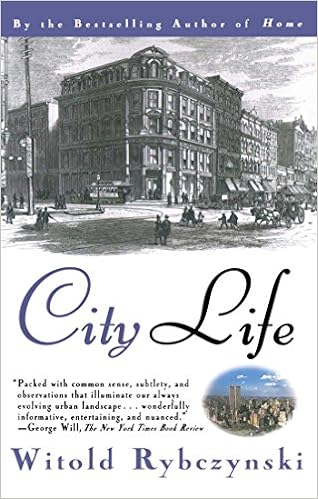City Life begins with a question that seems almost a complaint: Why aren't our cities (in North America) like Europe's cities? The author is in Paris, and his journey there reminds him of decades earlier when he was in the same place--and it seemed very much the same--the same beautiful old buildings and small streets and grand history. In the United States, by contrast, a city has been torn down and re-erected each decade. The places we treasure are temporal, our cities hardly of historical relevance. The complaint did not seem a worthy one, and this beginning made me think that the book was going to be one focused on why Europe's cities are so much better than ours--theoretical and snobbish.
But the introduction does not do the book justice. Really, Rybczynski is interested in knowing why our cities are not the same, and to answer that, he delves into history. The book, as it turns out, ends up being a history of the city--and of city planning. (And later in the book, he even notes that Europe's cities have begun to mimic American cities, as many of the revolutionary changes that cause our cities to be as they are have happened across the Atlantic as well.)
Rybczynski introduces us to three basic models for the city historically (first denoted by Kevin Lynch): the cosmic, the practical, and the organic. Cosmic cities would include those of the ancient Southeastern Ceremonial Complex and of the Aztecs and Incas. The city was centered around a mound or a temple. Religious practices forge the plan for the city--or governmental practices, as in the case of Washington, D.C. The practical city generally follows a grid created for maximum ease of commerce and expansion. Most North American cities fall into this model. The last model, the organic, would be typical of older European cities whose "grid" goes back to the Middle Ages--streets do not follow a rigid geometric plan. Rather, they grow organically as the population settles. To these three models Rybczynski adds a fourth, the automobile city. Modern spread-out cities with wide, long-curving streets are typical of these sort--Phoenix and Houston.
Rybczynski then turns to the Middle Ages and the concept of open and closed towns, walled and unwalled, and the cause for these differences in time and space--nobles looking to protect their station, serfs seeking protection, merchants looking to sell goods. From there, he goes to the colonial town, created differently for each culture, but for the English in three basic types: organic (informal, winding streets, as in Boston); gridlike with open squares (as in Cambridge); and linear (with one main street, as in Providence).
Grids soon became typical of city planning in the United States, as they were a means to keep towns organized even as they grew at phenomenal rates. After all, squares are easy to parcel out and sell.
Individual chapters cover the early growth and planning of New York and Chicago, the former mostly through the eyes of Tocqueville, on his visit to America, the latter through the eyes of the City Beautiful movement and the Chicago World's Fair. Rybczynski has some very different views on the City Beautiful movement from Jane Jacobs, who largely condemned it. As Rybczynski notes, the founders of that movement actually did pay attention to how cities worked and looked for council among city administrators. The World's Fair, however, had a large impact on the city and on American architecture in general, as its largely classical style was copied for permanent buildings elsewhere, as were the tendency to gather grand governmental structures together in complexes for great display (something Jacobs largely criticizes).
But Rybczynski largely criticizes the Radiant City concept espoused by Le Corbusier, which Jacobs also despised. That plan essentially put towers in the middle of parks. Le Corbusier, as it turns out, was more a philosopher than a planner, and he spoke a good, conceited game without having a lot of actual knowledge. Nevertheless, his ideas were put into practice in some places to disastrous effect, as in some public housing in the Chicago area, where crime has run rampant since. Part of this dynamic is social (the ACLU sued to prevent those who ran the complex from interviewing possible renters with the idea of managing proper diversity among the units; once that happened, increasing problems became part of a downward spiral); however, part of it rests in Jacobs's own ideas--if there isn't a crowd of people on the street and a diversity of use for parks, an area is less attractive and often less safe.
From there, Rybczynski delves into the growth of the suburb, which is largely due to the car. As people could settle farther out, in the country, they did so, and city centers began to decline. Suburbia is complex. In many cases, suburbs themselves end up with centers of their own, so that work doesn't always happen in the city. Also, with the advent of the car, shopping malls sprang up, placing all retail in a single location that people could drive to and then walk around within. Of particular importance here was the supermarket, allowing people to shop for a week or two rather than shopping for a day or two at a time. I was surprised to learn how recent the (indoor) shopping mall really is--going from about eight in the nation in 1950 to thousands by the 1960s. That malls are privately owned raises social questions as well, since unlike public downtown streets, limitations can be placed on free speech and assembly.
Cities themselves are largely growing smaller as their surroundings fill out, creating larger and larger metropolitan areas (both in land and population). The complex mix of cities and edge cities is the future.
Wednesday, February 17, 2016
On "City Life" by Witold Rybczynski ****
Labels:
Books,
Four-Star Nonfiction,
Nonfiction,
Urban Theory,
Witold Rybczynski
Subscribe to:
Post Comments (Atom)







No comments:
Post a Comment